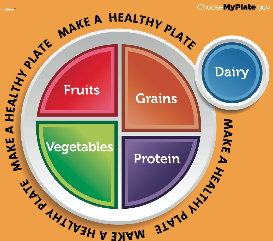Meet MyPlate
 MyPlate, the newest incarnation of the USDA’s food icons was introduced as a replacement for MyPyramid in June, 2011.It has five main food groups1. Fruits 2. Vegetables 3. Grains 4. Protein 5. DairyMyPlate provides a visual tool to teach you how to load your plate so you feel full on fewer calories and get plenty of fiber and nutrients.There’s also a companion website for MyPlate at http://www.choosemyplate.govMeet the Fruit GroupAny fruit can be part of the fruit group, though whole, fresh fruit is best. Try:• Fresh fruit – fill up on seasonal and bulk specials to save money• Canned fruit – packed in water or juice, not syrup• Dried fruit – use sparingly, as these are higher in calories• Frozen fruit - avoid added sugar• 100% fruit juice – get pure juice but remember whole fruit is better.People should eat about 1.5 to 2 cups of fruit per day.Meet the Vegetable GroupThere are five subgroups in the vegetable group. They are:• Dark green vegetables • Red and orange vegetables • Beans and peas • Starchy vegetables • Other vegetablesMost people should eat between 2.5 and 3 cups of veggies every day. Fill half your plate with fruits and vegetables.Most people need 4 to 5 cups of fruits and veggies each day!Meet the Grain GroupThere are two kinds of grains: whole and pro- cessed. Make at least half the grains you eat every day whole grains – they’re much better for you.Most people should eat between three and four ounces of grain per day.Meet the Protein GroupEat mostly lean protein and make sure it fills only a quarter of your plate.Foods that belong in the protein group include: Meat, Poultry, Seafood, Beans and peas, Eggs, Processed soy, Nuts, Seeds.Most people should eat between five and six ounces of protein per day. Get your protein from a variety of sources. Plant based protein is best for your heart.Meet the Dairy GroupSearch for products that are low in fat, sugar, and sodium including: Skim or 1% Milk, Non-fat yogurt.Cream, butter, and cream cheese are not significant sources of calcium.Most people should consume three cups of low-fat or fat-free dairy per day.
MyPlate, the newest incarnation of the USDA’s food icons was introduced as a replacement for MyPyramid in June, 2011.It has five main food groups1. Fruits 2. Vegetables 3. Grains 4. Protein 5. DairyMyPlate provides a visual tool to teach you how to load your plate so you feel full on fewer calories and get plenty of fiber and nutrients.There’s also a companion website for MyPlate at http://www.choosemyplate.govMeet the Fruit GroupAny fruit can be part of the fruit group, though whole, fresh fruit is best. Try:• Fresh fruit – fill up on seasonal and bulk specials to save money• Canned fruit – packed in water or juice, not syrup• Dried fruit – use sparingly, as these are higher in calories• Frozen fruit - avoid added sugar• 100% fruit juice – get pure juice but remember whole fruit is better.People should eat about 1.5 to 2 cups of fruit per day.Meet the Vegetable GroupThere are five subgroups in the vegetable group. They are:• Dark green vegetables • Red and orange vegetables • Beans and peas • Starchy vegetables • Other vegetablesMost people should eat between 2.5 and 3 cups of veggies every day. Fill half your plate with fruits and vegetables.Most people need 4 to 5 cups of fruits and veggies each day!Meet the Grain GroupThere are two kinds of grains: whole and pro- cessed. Make at least half the grains you eat every day whole grains – they’re much better for you.Most people should eat between three and four ounces of grain per day.Meet the Protein GroupEat mostly lean protein and make sure it fills only a quarter of your plate.Foods that belong in the protein group include: Meat, Poultry, Seafood, Beans and peas, Eggs, Processed soy, Nuts, Seeds.Most people should eat between five and six ounces of protein per day. Get your protein from a variety of sources. Plant based protein is best for your heart.Meet the Dairy GroupSearch for products that are low in fat, sugar, and sodium including: Skim or 1% Milk, Non-fat yogurt.Cream, butter, and cream cheese are not significant sources of calcium.Most people should consume three cups of low-fat or fat-free dairy per day.